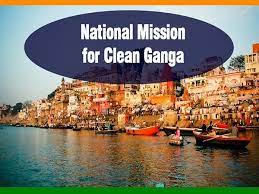12 May 2022 National Mission for Clean Ganga

Today Current Affairs
- Sixth edition of monthly ‘University Webinar’ series on ‘Igniting Young Minds, Rejuvenating Rivers’ under National Mission for Clean Ganga (NMCG).
- The theme of this webinar was ‘Waste Water Management’.
National Mission for Clean Ganga (NMCG) – Today Current Affairs
- The National Mission for Clean Ganga is implemented by the National Council for Rejuvenation, Conservation and Management of River Ganga which is also known as ‘National Ganga Council’.
- The National Mission for Clean Ganga (NMCG) acts as the implementing arm of the National Ganga Council, which was registered as a society on August 2011 under the Societies Registration Act, 1860.
Objective : The Hindu Analysis
- Mission includes retrofitting and promotion of existing Sewage Treatment Plants (STPs) and taking immediate short-term steps to prevent pollution at riverfront exit points to check sewage flows.
- Maintaining continuity of water flow without changes in natural weather changes.
- Enhance and maintain surface runoff and groundwater.
- To restore and maintain the natural flora of the area.
- To preserve and revive the aquatic biodiversity of the Ganges river basin as well as the coastal biodiversity.
- To allow public participation in the process of river conservation, rejuvenation and management.
Related Initiatives : The Hindu Analysis
- Namami Gange Programme: The Namami Gange Program is an integrated conservation mission approved by the Central Government in June 2014 as a ‘Flagship Programme’ to fulfill the twin objectives of effective abatement of pollution and conservation and rejuvenation of the National River Ganga.
- Ganga Action Plan: This was the first river action plan which was brought out by the Ministry of Environment and Forests in 1985. Its objective was to improve water quality through water logging, diversion and domestic sewage treatment, and to prevent toxic and industrial chemical wastes (from identified polluting units) from entering the river. The Hindu Analysis
- The National River Conservation Plan is an extension of the Ganga Action Plan. Its objective is to clean the river Ganga under Phase-2 of the Ganga Action Plan.
- National River Ganga Basin Authority (NRGBA): It was constituted by the Government of India in the year 2009 under Section-3 of the Environment Protection Act, 1986.
- River Ganga was declared as the ‘National River’ of India in 2008.
- Clean Ganga Fund: It was formed in the year 2014 to clean the Ganga, set up waste treatment plants and conserve the biological diversity of the river. The Hindu Analysis
- Bhuvan-Ganga Web App: It ensures public participation in monitoring the pollution in river Ganga.
- Ban on waste disposal: In the year 2017, the National Green Tribunal banned the disposal of any kind of waste in the river Ganga.
Ganga River System : The Hindu Analysis
- It originates from Gangotri Glacier near Gomukh (3,900 m) in Uttarakhand where it is known as Bhagirathi.
- Bhagirathi meets Alaknanda at Devprayag; thereafter it is known as Ganga.
- The Ganges enters Haridwar in the northern plains.
- The Ganges flows through Uttarakhand, Uttar Pradesh, Bihar and West Bengal. The Hindu Analysis
- Yamuna and Son are the main tributaries of the right bank and the important tributaries of the left bank are Ramganga, Gomti, Ghaghara, Gandak, Kosi and Mahananda.
- Yamuna is the westernmost and longest tributary of Ganga and its source is Yamunotri Glacier.
- The Ganges drains into the Bay of Bengal near Sagar Island.
Way ahead : The Hindu Analysis
- Monetization of sludge and treated water is one of the focus areas of the Namami Gange program under ‘Arth Ganga’, which means ‘Bridge of Economics’ or connecting people to the Ganges through a bridge of economy.
- Awareness generation and community-led efforts are needed in this work. Apart from the cultural and spiritual importance of the river Ganga, we should also pay attention to the economic benefits of the river.
- For a program like Namami Gange, it is necessary to bring social and practical change in the young generation and this can be brought only through proper dialogue.
- Targeted dissemination of information should be done to bring about the desired change. There is a need to make the generation aware about cleanliness and everything else will be fine automatically.


No Comments